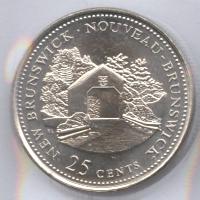
Status: Province
Minted: January, 1992
Description: New Brunswick is famous for its covered bridges like this one. In fact, the world's longest covered bridge, built in 1899 and spanning 1282 ft., is located at Hartland, New Brunswick.
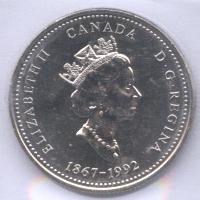
In 1992, the Canadian quarter was minted with thirteen different obverses featuring each of the twelve existing provinces and territories. (Because the new territory of Nunavut was not yet in existance, it was not represented. The thirteenth design, which was never placed into circulation, showed the caribou that traditionally appeared on the obverse.) The series was designed to celebrate the 125th anniversary of the 1867 Canadian Confederation (when the first of the seperate provinces united) by celebrating the provinces and territories that now comprise the Confederation. The beautiful coins, based on designs submitted by citizens, do a fantastic job of capturing the stunning vistas of Canada in such tiny images.
The order of issue was determined randomly, and each quarter design was issued for one month. Only about 10,000,000 of each coin design was made, and they were extremely popular with collectors. For these reasons, the coins disappeared from circulation within only a few years.
These quarters are a natural compliment to the US 50 State Quarters Program because the former was inspired in part by its Canadian predecessor and because together they form a unique gallery of the history and splendor of the North American continent.
 |
Area: New Brunswick Status: Province Minted: January, 1992 Description: New Brunswick is famous for its covered bridges like this one. In fact, the world's longest covered bridge, built in 1899 and spanning 1282 ft., is located at Hartland, New Brunswick. |  |
 |
Area: Northwest Territories Status: Territory Minted: February, 1992 Description: This statue of a human made by piling up large rocks is called an "inukshuk" (pronounced in-OOK-SHOOK). These markers were built by pre-Columbian Inuits all over the Canadian tundra. |  |
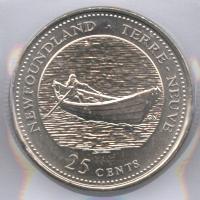 |
Area: Newfoundland Status: Province Minted: March, 1992 Description: The man in the dory (rowboat) symbolizes the province's traditional reliance on fishing. Times have been tough since the 1992 shutdown of the cod fishery, but the economy of this friendly province is being slowly rebuilt. |  |
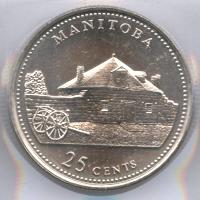 |
Area: Manitoba Status: Province Minted: April, 1992 Description: The Hudson's Bay Company, which today is headquartered in Manitoba, built numerous forts in the area in search of beaver pelts. Part of one such fort is pictured here. (It may be Fort Rouge.) |  |
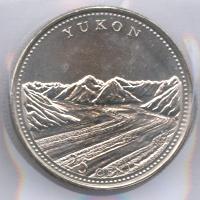 |
Area: Yukon Status: Territory Minted: May, 1992 Description: Glaciers are "rivers" of ice layered so thick that the pressure causes them to slowly flow. The lines of debris running through the center of the glacier are called moraines. |  |
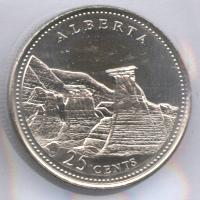 |
Area: Alberta Status: Province Minted: June, 1992 Description: These mushroom-shaped rock formations are called hoodoos and occur in Alberta's badlands. |  |
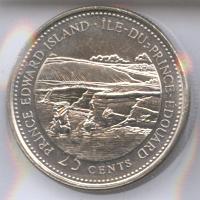 |
Area: Prince Edward Island Status: Province Minted: July, 1992 Description: The beautiful coastline of Prince Edward Island is made of distinctive red clay. Potatoes, which thrive in this soil, are the island's main crop. |  |
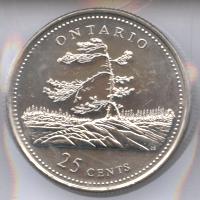 |
Area: Ontario Status: Province Minted: August, 1992 Description: The combination of evergreen tree and rocky outcropping is symbolic of the Canadian Shield, a huge, 4-billion-year-old rock formation that lines the south and west of Hudson Bay. |  |
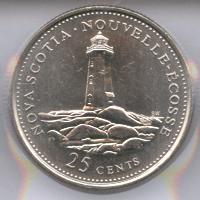 |
Area: Nova Scotia Status: Province Minted: September, 1992 Description: The lighthouse at Peggy's Cove is one of the last in a province known for its maritime history. The rocky cove with crashing waves is a beautiful sight. |  |
 |
Area: Quebec Status: Province Minted: October, 1992 Description: Percé Rock at the tip of the Gaspé Peninsula is the gateway to the historic St. Lawrence River. |  |
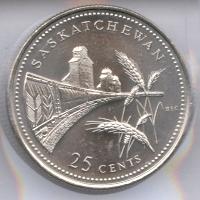 |
Area: Saskatchewan Status: Province Minted: November, 1992 Description: It's called the 'Bread Basket of the World' and has an extensive wheat industry and a square reputation. The Canadian who explained the quarters to me wrote that to get the drift US citizens just need to think 'Kansas.' |  |
 |
Area: British Columbia Status: Province Minted: December, 1992 Description: This scenic province is known for its mountains, Pacific Northwest climate, and the many whales that grace its coasts with their presence. |  |
Thanks to M.B. of Toronto for sharing the information used in the creation of this page!